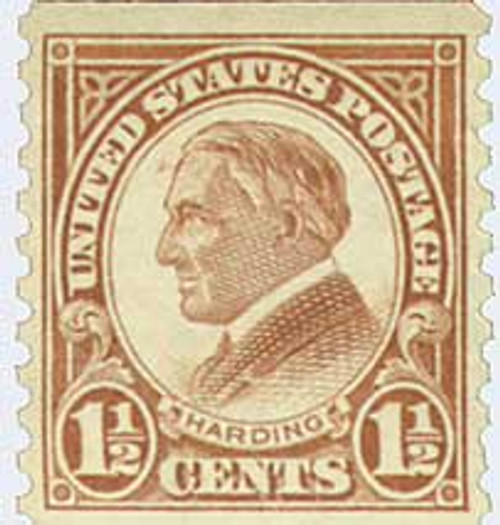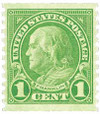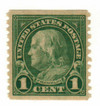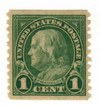
1923 1c Franklin, green, coil
# 597 - 1923 1c Franklin, green, coil
$0.35 - $3.00
U.S. #597
Series of 1923-29 1¢ Ben Franklin
Series of 1923-29 1¢ Ben Franklin
Issue Date: July 18, 1923
First City: Washington, D.C.
Quantity Issued: 2,147,680,500
Printed by: Bureau of Engraving and Printing
Printing Method: Rotary Press
Perforation: 10 vertically
Color: Green
First City: Washington, D.C.
Quantity Issued: 2,147,680,500
Printed by: Bureau of Engraving and Printing
Printing Method: Rotary Press
Perforation: 10 vertically
Color: Green
The 1¢ U.S. #597 was issued six months after the 2¢ coil stamp, and remained in production for 14 years. Over the long course of its production a wide variety of shades were issued, ranging from bright yellowish green to deep blue green.
Ben Franklin – Former Postmaster For British Crown
Ben Franklin, shown on U.S. #597, was dismissed as deputy postmaster for the American Colonies in 1774, in part because of his role in the “Hutchinson Letters” affair. The affair concerned private letters of the Massachusetts governor given to Franklin that were later published in a newspaper. But Franklin was still allowed to use his “franking” privilege, meaning he could send letters for free by signing the outside of the letters. He would sign “B. Free Franklin” – which some have taken to reflect his patriotic feelings.
Precancel Machine Increases Bureau Efficiency
The results from the experiment involving the 1¢ Franklin being printed on the rotary press prompted the Bureau to consider adopting this method to produce the remaining stamps in the series. By 1925, the rotary press was being used to print all values from 1¢ to 10¢. However, as with all innovations, problems arose. Postmasters complained that sheets were curling, making it difficult to apply precancels.
In order to simplify the mail-handling procedure, cancelations were applied to the stamps with a special device before being sold and affixed to mail. Mainly used in large cities such as New York, Boston, and Chicago, these precancels allowed postal clerks to handle mail more efficiently and promptly. A new device, developed by Richard Breaden, used an electrotype plate to print the precancels. The 1¢ stamp was used experimentally to produce the first Bureau precancels, which were issued in New York City on April 23, 1923.
This new machine alone saved the Bureau over $250,000 per year in labor costs. When added to lowered production costs of the rotary press, the Bureau was able to save a considerable sum of money. Eventually, the precancel device was combined with the rotary press, further reducing production time and cost. The process was further improved when a new perforator allowed the stamps to be printed, gummed, precanceled, and perforated on the same machine, eliminating the need to handle the sheets between the various stages.
U.S. #597
Series of 1923-29 1¢ Ben Franklin
Series of 1923-29 1¢ Ben Franklin
Issue Date: July 18, 1923
First City: Washington, D.C.
Quantity Issued: 2,147,680,500
Printed by: Bureau of Engraving and Printing
Printing Method: Rotary Press
Perforation: 10 vertically
Color: Green
First City: Washington, D.C.
Quantity Issued: 2,147,680,500
Printed by: Bureau of Engraving and Printing
Printing Method: Rotary Press
Perforation: 10 vertically
Color: Green
The 1¢ U.S. #597 was issued six months after the 2¢ coil stamp, and remained in production for 14 years. Over the long course of its production a wide variety of shades were issued, ranging from bright yellowish green to deep blue green.
Ben Franklin – Former Postmaster For British Crown
Ben Franklin, shown on U.S. #597, was dismissed as deputy postmaster for the American Colonies in 1774, in part because of his role in the “Hutchinson Letters” affair. The affair concerned private letters of the Massachusetts governor given to Franklin that were later published in a newspaper. But Franklin was still allowed to use his “franking” privilege, meaning he could send letters for free by signing the outside of the letters. He would sign “B. Free Franklin” – which some have taken to reflect his patriotic feelings.
Precancel Machine Increases Bureau Efficiency
The results from the experiment involving the 1¢ Franklin being printed on the rotary press prompted the Bureau to consider adopting this method to produce the remaining stamps in the series. By 1925, the rotary press was being used to print all values from 1¢ to 10¢. However, as with all innovations, problems arose. Postmasters complained that sheets were curling, making it difficult to apply precancels.
In order to simplify the mail-handling procedure, cancelations were applied to the stamps with a special device before being sold and affixed to mail. Mainly used in large cities such as New York, Boston, and Chicago, these precancels allowed postal clerks to handle mail more efficiently and promptly. A new device, developed by Richard Breaden, used an electrotype plate to print the precancels. The 1¢ stamp was used experimentally to produce the first Bureau precancels, which were issued in New York City on April 23, 1923.
This new machine alone saved the Bureau over $250,000 per year in labor costs. When added to lowered production costs of the rotary press, the Bureau was able to save a considerable sum of money. Eventually, the precancel device was combined with the rotary press, further reducing production time and cost. The process was further improved when a new perforator allowed the stamps to be printed, gummed, precanceled, and perforated on the same machine, eliminating the need to handle the sheets between the various stages.





















